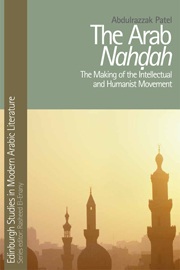Book contents
- Frontmatter
- Contents
- Series Editor's Foreword
- Acknowledgements
- Preface
- Introduction: Perspectives, Paradigms and Parameters
- 1 Contemporary Interpretations of the Nahḍah: Tradition, Modernity and the Arab Intellectual
- 2 The Reintegration of Pre-modern Christians into the Mainstream of Arabic Literature and the Creation of an Inter-religious Cultural Space
- 3 Guardians of the Pre-modern Arab-Islamic Humanist Tradition: Legends without a Legacy, a Tradition without Heirs
- 4 Language Reform and Controversy: The al-Shartūnīs Respond in Defence of the Pre-modern Humanist Tradition
- 5 Arabism, Patriotism and Ottomanism as Means to Reform
- 6 Arab Intellectuals and the West: Borrowing for the Sake of Progress
- 7 Education, Reform and Enlightened Azharīs
- 8 Enacting Reform: Local Agents, Statesmen, Missionaries and the Evolution of a Cultural Infrastructure
- Conclusion
- Bibliography
- Index
Conclusion
Published online by Cambridge University Press: 05 October 2013
- Frontmatter
- Contents
- Series Editor's Foreword
- Acknowledgements
- Preface
- Introduction: Perspectives, Paradigms and Parameters
- 1 Contemporary Interpretations of the Nahḍah: Tradition, Modernity and the Arab Intellectual
- 2 The Reintegration of Pre-modern Christians into the Mainstream of Arabic Literature and the Creation of an Inter-religious Cultural Space
- 3 Guardians of the Pre-modern Arab-Islamic Humanist Tradition: Legends without a Legacy, a Tradition without Heirs
- 4 Language Reform and Controversy: The al-Shartūnīs Respond in Defence of the Pre-modern Humanist Tradition
- 5 Arabism, Patriotism and Ottomanism as Means to Reform
- 6 Arab Intellectuals and the West: Borrowing for the Sake of Progress
- 7 Education, Reform and Enlightened Azharīs
- 8 Enacting Reform: Local Agents, Statesmen, Missionaries and the Evolution of a Cultural Infrastructure
- Conclusion
- Bibliography
- Index
Summary
The story of the nahḍah is highly complex and inadequately understood. At present, there is a real need for new works of synthesis that capture its broader outlines: how the nahḍah emerged, how it was understood and its impact into the contemporary period. Existing overviews, no matter how good, are now largely outdated. The various versions of the nahḍah have mainly been an account of the different mappings of the complex relationship between the Arab world and the West following the French invasion of Egypt in 1798. The encounter with colonialism in the nineteenth century gave rise to new scholarly discourses through which Western historians generated new paradigms of civilisational rise and fall. More specifically, the accepted method for understanding the rise and development of the nahḍah within Arab cultural history has been to speak in terms of certain binary opposites, such as tradition/modernity, decline/renaissance, decadence/ renewal and stagnation/revival. These two antinomies, as Schulze points out, would govern all representation and self-representation of the history and culture of the Arabs as ‘the basis of a concept of cultural history which, of course, reflected the [European] political interpretation of historical development current in the nineteenth century’.
An integral part of the Orientalist paradigm, which reads Arab cultural history in terms of a civilisational rise and fall model, is a classical ‘golden age’ in the ninth and tenth centuries, now long forgotten, and hence cut off from the movement of history.
- Type
- Chapter
- Information
- The Arab NahdahThe Making of the Intellectual and Humanist Movement, pp. 224 - 233Publisher: Edinburgh University PressPrint publication year: 2013



